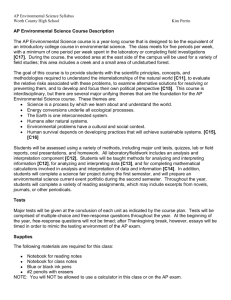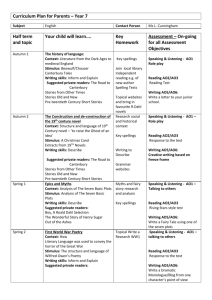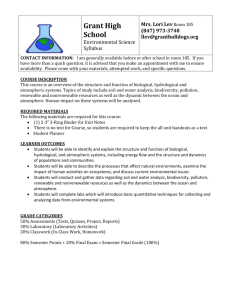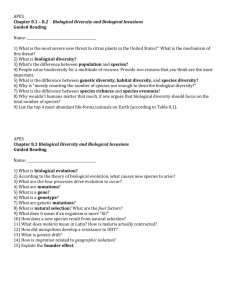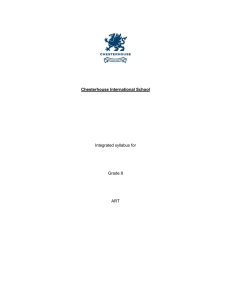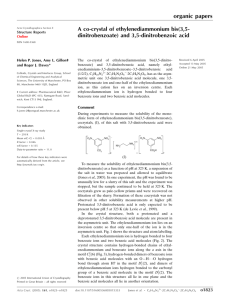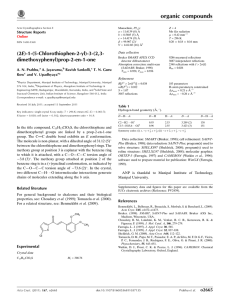APES Syllabus - Worth County Schools
advertisement
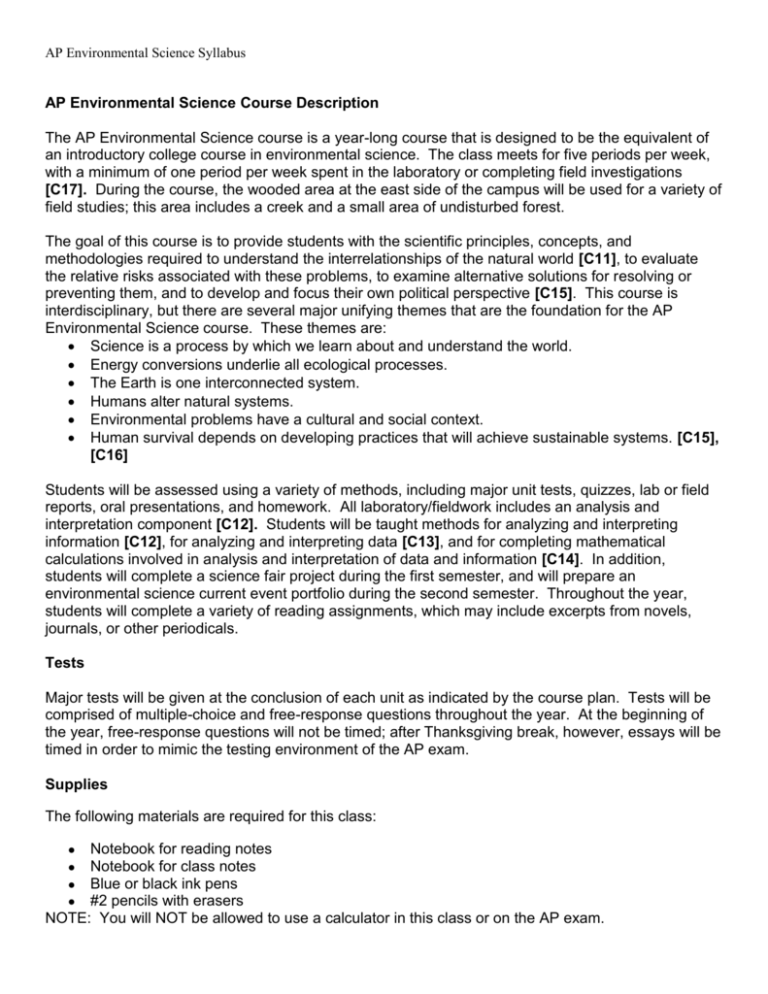
AP Environmental Science Syllabus AP Environmental Science Course Description The AP Environmental Science course is a year-long course that is designed to be the equivalent of an introductory college course in environmental science. The class meets for five periods per week, with a minimum of one period per week spent in the laboratory or completing field investigations [C17]. During the course, the wooded area at the east side of the campus will be used for a variety of field studies; this area includes a creek and a small area of undisturbed forest. The goal of this course is to provide students with the scientific principles, concepts, and methodologies required to understand the interrelationships of the natural world [C11], to evaluate the relative risks associated with these problems, to examine alternative solutions for resolving or preventing them, and to develop and focus their own political perspective [C15]. This course is interdisciplinary, but there are several major unifying themes that are the foundation for the AP Environmental Science course. These themes are: Science is a process by which we learn about and understand the world. Energy conversions underlie all ecological processes. The Earth is one interconnected system. Humans alter natural systems. Environmental problems have a cultural and social context. Human survival depends on developing practices that will achieve sustainable systems. [C15], [C16] Students will be assessed using a variety of methods, including major unit tests, quizzes, lab or field reports, oral presentations, and homework. All laboratory/fieldwork includes an analysis and interpretation component [C12]. Students will be taught methods for analyzing and interpreting information [C12], for analyzing and interpreting data [C13], and for completing mathematical calculations involved in analysis and interpretation of data and information [C14]. In addition, students will complete a science fair project during the first semester, and will prepare an environmental science current event portfolio during the second semester. Throughout the year, students will complete a variety of reading assignments, which may include excerpts from novels, journals, or other periodicals. Tests Major tests will be given at the conclusion of each unit as indicated by the course plan. Tests will be comprised of multiple-choice and free-response questions throughout the year. At the beginning of the year, free-response questions will not be timed; after Thanksgiving break, however, essays will be timed in order to mimic the testing environment of the AP exam. Supplies The following materials are required for this class: ● ● ● ● Notebook for reading notes Notebook for class notes Blue or black ink pens #2 pencils with erasers NOTE: You will NOT be allowed to use a calculator in this class or on the AP exam. AP Environmental Science Syllabus APES in the News Environmental science is a frequently changing and evolving field of study. To promote well-read and informed students, each one is required to participate in the APES in the News assignment. Twice during the third and fourth grading periods, each student must find a newspaper or magazine article relating to environmental science, read through the article, and write a one-page (double-spaced) reflection. Additionally each student will be required to produce an APES in the news assignment during spring break. A total of five APES in the News articles must be completed by the end of the school year. One of the five articles must come from a newspaper clipping from a different state/country. No repeat articles allowed. Textbook and Resources ● ● Miller, G. (2007). Living in the Environment, 17th Edition. Pacific Grove, CA: Brooks/Cole Thomson Learning. Additional articles from Discover, Scientific American, and other journal will supplement the textbook reading. Methods Instruction will consist of lectures, discussions, cooperative learning activities, demonstrations, lab or field work, and written assignments—including research projects, in-class assignments, and homework. Approximately one period per week is devoted to hands-on laboratory experiences or fieldwork. All lab and fieldwork requires a written report which will be kept in a designated laboratory notebook. This notebook may be required by certain institutions at a later date. Course Planner UNIT 1— Introduction to Environmental Science TOPICS/CONCEPTS Environmental problems and causes History of resources’ use and conservation Scientific method and models LABS AND ACTIVITIES[C17] The Lorax vs. The Truax Namedroppers (historical contributions to environmental science) Project: Environmental Laws research Lab: Ecological Footprint Lab: Parts per million (serial dilution) [C14] Lab/Activity: Tragedy of the Commons TEST—Introduction and Chapter 1 and 2 TIME 3 weeks AP Environmental Science Syllabus 2—Matter and Energy [C3] 3—Air and the Atmosphere [C1] Transfer of matter and energy in the ecosystem [C3] Biogeochemical cycles Relationships in ecosystems Review of basic chemistry Laws of Thermodynamics Energy flow in ecosystems Air Air pollution [C9] The atmosphere Climate change Stratospheric ozone [C10] Weather Global Warming [C10] Biogeochemical Cycles (internet activity) Lab: Irradiated seeds [C13] Lab: Predator/Prey Activity: Food Web model Cats of Borneo reading Lab: Biomagnification [C13] Lab: Acid/base lab Population math/APES math skills TEST: chapter 3 2 weeks Lab: Albedo [C12] Lab: Testing for ground-level ozone [C15] Lab: Acid Rain Lab: Particulate Collection Vernier Probe Labs (CO2, relative humidity, UV) [C15] Lab: Measuring automobile pollutants 4 weeks TEST: chapter 18 and 19 4—Biodiversity and Ecosystems [C3] 5—Sustaining Biodiversity [C10] 6—Human Impact and Population [C4] Biodiversity of species Evolution of species and natural selection Community ecology Sustaining biodiversity Lab: Parking Lot Biodiversity (Shannon-Wiener diversity index) [C12], [C13] Project: Biomes Activity: Climatograms Activity: Simulation of natural selection Lab: Biodiversity in Leaf Litter (Shannon-Wiener) [C12], [C13] Lab: Brine Shrimp Abiotic Factors Lab: Interspecific and Intraspecific competition Aquatic and Terrestrial Biodiversity Sustaining wild species Biodiversity and extinction [C10] TEST: Chapters 3,4,5 Lab: Macroinvertebrate lab (use stream on school grounds)—will take lab time during this unit [C13] Project: Endangered Animal Research Video: Cane Toads Human population and its impact Population dynamics TEST: Chapters 7,8,9,10,11 Lab: Power of the Pyramids Lab: Something Fishy Lab: Histograms Lab: The power of doubling 3 weeks 3 weeks 2 weeks AP Environmental Science Syllabus 7—Human Health and the Environment [C16] 8—Geology [C1], [C2] 9—Land Use [C5] Human health Risk and toxicology LD 50 Diseases Pesticides and pest control Earth Science Concepts [C1] [C2] Plate tectonics Land formations Mining Rocks and minerals Soil and soil dynamics Food resources Feeding populations calories Urban land use Forestry Other Land Use Transportation infrastructure Public and federal lands Land conservation options Sustainable landuse strategies 10—Water Resources and Use [C1] [C2] [C6] Sampling Fishing Water resources Water pollution [C9] Testing water quality 11—Solid Solid waste TEST: Chapter 6 Activity: Disease reports Lab: LD 50 Activity: Risk Perception and Risk Reality Video: Ebola Activity: Zombie Case study (will include preparation and in-class debate—ecological and human health risks) [C16] TEST: Chapter 17, 12-section 4 Lab: Rocks and Minerals Lab: Plate Tectonics Lab: Soil Lab Lab: Cookie Mining Field Trip: Providence Canyon Activity: Scale Model of Earth TEST: Chapter 14, 12 Lab: Counting Calories Project: Land Use planning 3 weeks 3 weeks 2 weeks TEST: Chapters 22, 12 Lab: Chemical Testing/Water quality/aquatic sampling [C12] [C13] Lab: Water diversion Lab: Salinization Lab: Drop by drop Activity: Who Dirtied the water? And Is it safe to drink? [C15] Field Trip: Radium Springs, Riverquarium TEST: Chapters 13, 20 Lab: Wastewater Treatment 3 weeks 2 AP Environmental Science Syllabus Waste [C9] Recycling Disposal Wastewater treatment Activity: Recycle City Lab: Landfills and Recycling weeks TEST: Chapter 21 12—Energy Resources and Consumption [C7] [C8] Energy consumption Energy efficiency Renewable energy Types of energy Nuclear energy Hydroelectric power Review for AP exam Ecological Planning Project Final Exams Lab: Personal Energy Audit Activity: Carbon Footprint (internet) Activity: Fossil Fuels Activity: Energyville (Chevron— internet) [C12] [C15] Video: Chernobyl TEST: Chapters 15, 16 2 weeks 2 weeks 2 weeks
